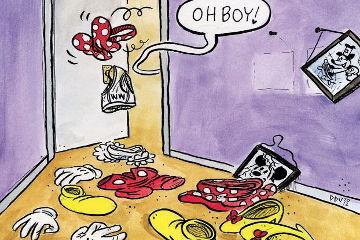What I’ve Learned:
“Nude mouse: Taking it ALL off for science.”
This being the internet, you might think “nude mouse” is the title of a Mickey and Minnie fan erotica script.
And probably it is. Rule 34, after all.
But for biologists — regardless of any disturbing Disney peccadilloes they might harbor — a nude mouse is something else, and something tremendously useful for research. Nude mice have genetic mutations in the FOXN1 gene, an important transcription factor highly conserved among mice, rats and humans, among others.
Knocking out FOXN1 function has two main effects. First, it prevents the proper growth of hair and nails. That’s the “nude” part of “nude mouse”, as FOXN1-deficient mice are a bunch of hairless, wrinkly pink monstrosities. It’s like watching a four-legged horde of that old guy from the Six Flags commercials a while back. Only with less dancing, probably.
That’s because the other effect of disrupting FOXN1 is an underdeveloped or absent thymus. The thymus is the organ where T cells develop, so missing a thymus leaves a nude mouse severely immunodeficient. They’re susceptible to virus infections and tumors, can’t mount cell-mediated immune responses and are unable to reject transplanted tissues.
That’s no picnic, if you’re a nude mouse. But if you’re a researcher studying infections diseases, cancer, immunodeficiency or treatment of human cells in an animal model, then it’s pretty sweet. Nude mice have been used extensively in studies using xenografts, or tissue from one species implanted into another. Human tumor cells, for instance, might be xenotransplanted into a nude mouse, which is then treated with an anti-cancer compound to see how well it works in a live animal.
Which is to say, a live nude animal. Sexay.
The first naturally-occurring nude mouse was discovered in the 1960s. I assume it was easy to spot back then, as it would have been the only lab mouse without an afro. Because there are many possible mutations that can disrupt FOXN1, several distinct strains of nude mouse have been described.
(Described as “wrinkly little E.T.-looking freaks”, I imagine. But still.)
Most nude mouse strains are “leaky”, which is significantly less icky than it sounds. Here, it just means that the mice retain some thymic function, and often low levels of T cells. Because we humans think we always know the best way to do everything, we’ve now developed knockout mice, where genes important for T cell development are completely scrambled, and there’s no pesky leaking.
So the nude mouse isn’t used as often these days in lab research, but these bald mutant rodents have helped make breakthroughs in immunology, oncology, parasitology, pharmaceutical research and more.
But NOT Disney-inspired fan erotica. Get those minds out of the gutter, people.



